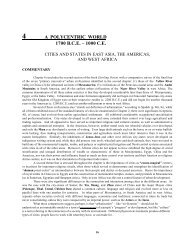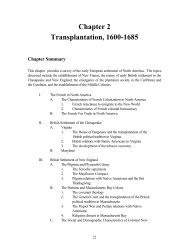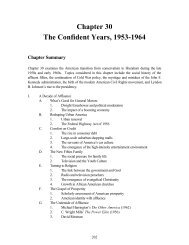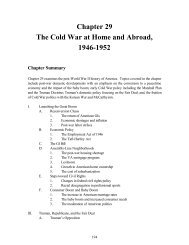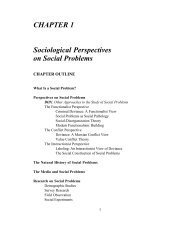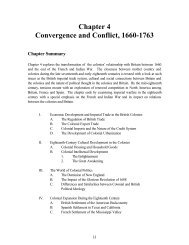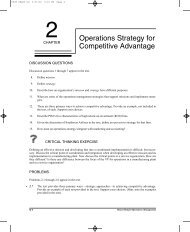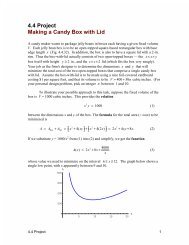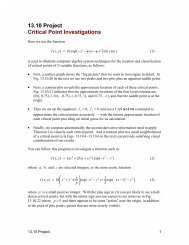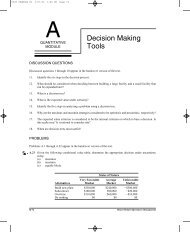Merchandising Operations and the Accounting Cycle - Pearson
Merchandising Operations and the Accounting Cycle - Pearson
Merchandising Operations and the Accounting Cycle - Pearson
You also want an ePaper? Increase the reach of your titles
YUMPU automatically turns print PDFs into web optimized ePapers that Google loves.
Decision Guidelines<br />
How do merch<strong>and</strong>ising operations differ from service<br />
operations?<br />
How do a merch<strong>and</strong>iser’s financial statements differ<br />
from <strong>the</strong> financial statements of a service business?<br />
Income statement:<br />
Merch<strong>and</strong>iser<br />
Sales revenue ....................................... $XXX<br />
– Cost of goods sold ................................ (X)<br />
= Gross margin......................................... $ XX<br />
– Operating expenses.............................. (X)<br />
= Net income ........................................... $ X<br />
What types of inventory systems are <strong>the</strong>re?<br />
How do <strong>the</strong> adjusting <strong>and</strong> closing processes of<br />
merch<strong>and</strong>isers <strong>and</strong> service entities differ?<br />
How to format <strong>the</strong> merch<strong>and</strong>iser’s income statement?<br />
Multi-step format<br />
Sales revenue ....................................... $XXX<br />
– Cost of goods sold ................................ (X)<br />
= Gross margin......................................... $ XX<br />
– Operating expenses.............................. (X)<br />
+ O<strong>the</strong>r revenues ..................................... X<br />
= Net income ........................................... $ XX<br />
How to evaluate inventory operations?<br />
How to determine <strong>the</strong> amount of cost of goods sold?<br />
<strong>Merch<strong>and</strong>ising</strong> <strong>Operations</strong> <strong>and</strong> <strong>the</strong> <strong>Accounting</strong> <strong>Cycle</strong><br />
• Merch<strong>and</strong>isers buy <strong>and</strong> sell merch<strong>and</strong>ise inventory (often called<br />
inventory, or goods).<br />
• Service entities perform a service.<br />
Balance sheet:<br />
• Merch<strong>and</strong>iser has inventory, current asset.<br />
• Service business has no inventory.<br />
Service Business<br />
Service revenue .................................... $XX<br />
– Operating expense................................ (X)<br />
= Net income ........................................... $ X<br />
Statements of retained earnings:<br />
No difference<br />
• Perpetual system shows <strong>the</strong> amount of inventory on h<strong>and</strong> (<strong>the</strong><br />
asset) <strong>and</strong> <strong>the</strong> cost of goods sold (<strong>the</strong> expense) at all times.<br />
• Periodic system shows <strong>the</strong> correct balances of inventory <strong>and</strong><br />
cost of goods sold only after a physical count of <strong>the</strong> inventory<br />
<strong>and</strong> adjustment of <strong>the</strong> books to reflect that count, which occurs<br />
at least once each year.<br />
Very little. The merch<strong>and</strong>iser may have to adjust <strong>the</strong> Inventory account<br />
for spoilage <strong>and</strong> <strong>the</strong>ft. The merch<strong>and</strong>iser must close <strong>the</strong> Cost<br />
of Goods Sold account. Service entities have no inventory to adjust<br />
or cost of goods sold to close.<br />
Single-step format<br />
Revenues:<br />
Sales revenue......................................... $ XXX<br />
O<strong>the</strong>r revenues ....................................... X<br />
Total revenues....................................<br />
Expenses:<br />
$ XXX<br />
Cost of goods sold.................................. (X)<br />
Operating expenses................................ (X)<br />
Total expenses ................................... $ XX<br />
Net income ............................................. $ XX<br />
Two key ratios:<br />
Gross margin percentage* = Gross margin<br />
Net sales revenue<br />
Inventory turnover* = Cost of goods sold<br />
Average inventory<br />
*In most cases—<strong>the</strong> higher, <strong>the</strong> better<br />
Can use <strong>the</strong> cost of goods sold model from <strong>the</strong> periodic<br />
system (assumed amounts):<br />
Beginning inventory ....................... $100<br />
+ Net purchases <strong>and</strong> freight in ......... 800<br />
= Cost of goods available.................. 900<br />
– Ending inventory............................. (200)<br />
= Cost of goods sold.......................... $700<br />
Cost of goods sold is computed automatically in <strong>the</strong><br />
perpetual inventory system.<br />
Chapter Five <strong>Merch<strong>and</strong>ising</strong> <strong>Operations</strong> <strong>and</strong> <strong>the</strong> <strong>Accounting</strong> <strong>Cycle</strong> 249



